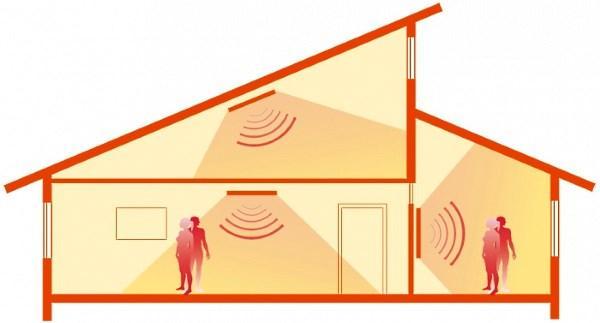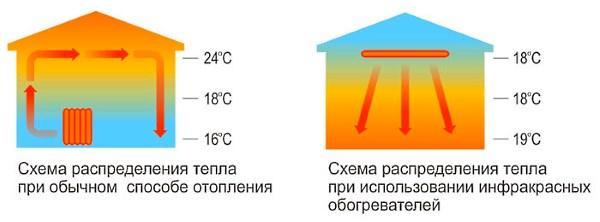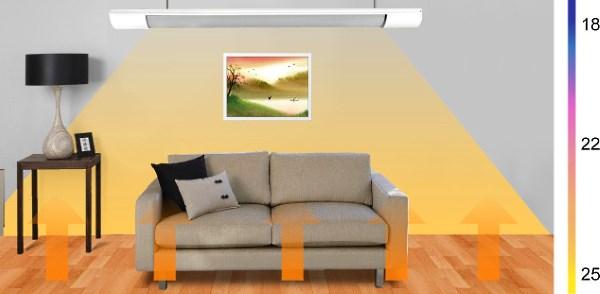Infrared heaters: types and selection rules
The current range of heating devices allows you to create comfortable living conditions for a person in almost any room and climatic conditions. In modern heaters, both time-tested and completely new technologies are used to save energy and make the most of the heat generated by the device.
Infrared devices used both in industrial facilities and in everyday life are recognized as one of the most economical heaters.
How does an infrared heater work?
The creators of infrared heaters borrowed the principle of operation of devices from the sun. Infrared radiation increases the temperature background of those objects that meet in the path of the rays, without heating the air. The temperature in the room rises already due to the transfer of heat from furniture, furnishings and other surfaces.

This is how the sun's rays work, a similar principle of operation for infrared heaters. Since it is not the air that heats up in the room, but the environment, the material of the floor, walls and ceiling, the effect of using the device remains long enough, the atmosphere inside does not dry out, and the amount of oxygen does not drop. At the same time, energy saving during heating is 50% on average. But in order for infrared heating to be as efficient as possible, the power of the devices and their placement should be selected taking into account the height of the room, its area and other parameters.

If all calculations and installation are carried out correctly, then within a minute after starting the device, a comfortable atmosphere for a person is created. And heaters can serve as an excellent additional, and sometimes the main source of heat.

What are good about IR heaters (video)
Benefits of infrared heaters
- Depending on the conditions of use and the design of infrared heaters, using such equipment can save up to 80% energy compared to heat fans or convection-type appliances.
- These are environmentally friendly, completely silent devices.
- All infrared devices are compact, lightweight and can be used both in premises for various purposes and outside enclosed spaces.
- Infrared heaters are ideal when additional or temporary heating is required.
- The speed of heating the room is much higher than when using other heating devices of similar power.
- Heating quality is not affected by existing heat leaks in the room, such as drafts.
- Heaters do not affect the percentage of oxygen in the air and its humidity.
Cons of infrared heaters
With many positive characteristics, infrared heaters have disadvantages:
- Firstly, some models of heaters require a more careful attitude than unpretentious convection batteries or other designs. Here, it is better to protect the heater elements from falls, shocks or other influences.
- Secondly, infrared devices may not affect well-being in the best way, sometimes causing headaches, weakness and depression. We must not forget about the rather strong glow of the device, therefore, it is better to turn off such heaters at night.
Classification
Whatever the model of such heaters, the common thing in their design is the emitter, which is a source of infrared rays. In this case, devices can differ in the range of radiation, used by the source of energy, power and other characteristics.
Electrical
Such designs are most often used in everyday life. They are compact, reliable and easy to use. Moreover, in such ceiling, floor or wall heaters, the infrared emitter is heated by electricity, but the material for such a heating element may be different.

- Ceramic heaters got this name due to the heating element, which is a resistive cable enclosed in a ceramic case, which does not conduct current, but does not prevent the spread of infrared radiation. Such devices are extremely diverse in design and design and are often used in everyday life.
- Carbon infrared heaters according to reviews, they are more economical than ceramic. Here, the role of the emitter is played by a carbon fiber or carbon fiber located in a vacuum quartz tube. In addition to the heating effect, special models of such devices can be used by physicians as therapeutic devices.
 Flat film infrared heaters harmoniously fit into residential and office interiors, as they often imitate decorative panels. And miniature heating elements are mounted on a special heat-resistant film with a printed pattern. When buying such a device, it is important to remember that the film coating heats up to 75 ° C, which means that the device should be located outside the reach of family members or pets.
Flat film infrared heaters harmoniously fit into residential and office interiors, as they often imitate decorative panels. And miniature heating elements are mounted on a special heat-resistant film with a printed pattern. When buying such a device, it is important to remember that the film coating heats up to 75 ° C, which means that the device should be located outside the reach of family members or pets.
Gas
 Industrial and outdoor infrared gas heaters differ in greater thermal power than electrical appliances. This explains their frequent use in large premises, for example, in workshops, warehouses and hangars, as well as in large sports or entertainment facilities, where the ceiling height can reach 15 meters. As a fuel, such devices consume various types of gas from natural to coke oven gas.
Industrial and outdoor infrared gas heaters differ in greater thermal power than electrical appliances. This explains their frequent use in large premises, for example, in workshops, warehouses and hangars, as well as in large sports or entertainment facilities, where the ceiling height can reach 15 meters. As a fuel, such devices consume various types of gas from natural to coke oven gas.
There are interesting varieties of infrared gas heaters that can be used outdoors. These "thermal umbrellas" are ideal for a comfortable pastime on an open veranda or terrace.

Video review of the gas infrared heater Aeroheat IG 2000
https://www.youtube.com/watch?v=n9qa7IYFpws
Liquid fuel
These models, kerosene-fired or diesel fuel, can be seen at industrial sites and construction sites. As a rule, very powerful, compact and easily movable devices are used not only for heating, but also in technological processes. An example of this is the drying of raw materials in woodworking industries or the installation of stretch ceiling coverings.
Wavelength classification
IR heaters are also classified according to the length of the emitted waves:
- Shortwave heaters are easily recognized when switched on. They emit beams that are clearly visible to the human eye and are classified as light-type devices. The wavelengths here are in the range from 0.74 to 2.5 microns, which gives powerful heating. The temperature of the emitter reaches 800 ° C, which is higher than that of other types of devices. Such devices are used in large industrial facilities, and in open areas, and in residential buildings.
- Medium wave heaters, called gray heaters, emit waves between 2.5 and 50 microns. The emitting element heats up to 600 degrees, and the devices in terms of heat flow power and price are of the middle class. These types of infrared heaters are truly versatile and can be used in production, in domestic conditions and even outside the walls of the house.
- Long-wave heaters are sources of waves in the range from 50 to 1000 microns, which the human eye cannot fix. Therefore, such devices are called dark. The temperature of the heating element here reaches 300 ° C, the heat flux from such a device is not as intense as in the case of light or gray devices, but the cost of this type of heater is much lower. The device is suitable for closed small spaces, but ineffective in outdoor conditions.
Selection rules
The range of heating devices of various designs is extremely wide today. Therefore, before choosing an infrared heater, you should understand the criteria for such a choice.
- The main criterion is the power of the heater, which is calculated based on the parameters of the room and the presence of other heat sources.
- For small, for example, living quarters, it is better to purchase electric heaters.
- Floor-standing models are often more powerful than wall-mounted or ceiling-mounted devices.
- For country houses, where the power supply is not always stable, systems on liquefied gas are chosen.
- Gas powered devices can be equipped with cylinders of different capacities.
- Household appliances can be equipped with convenient thermostats, control panels and automation that allows you to set a comfortable mode of using the device.
Design and installation features
 Since household infrared electric heaters, according to consumer reviews, are rightly recognized as the most ergonomic and innovative devices, they are not yet as popular as oil or convection appliances... Therefore, the desire of manufacturers to make the use of infrared devices as convenient as possible, and the devices themselves, stylish and technological, becomes understandable.
Since household infrared electric heaters, according to consumer reviews, are rightly recognized as the most ergonomic and innovative devices, they are not yet as popular as oil or convection appliances... Therefore, the desire of manufacturers to make the use of infrared devices as convenient as possible, and the devices themselves, stylish and technological, becomes understandable.
Infrared heating equipment can, and sometimes even recommended, be mounted on the ceiling or walls. At the same time, the design of fasteners for ceiling infrared heaters for home and summer cottages makes it possible not to hang the devices on special brackets, the heaters can be built into the ceiling sheathing.

Portable heaters are equipped with tripods to adjust the device to a comfortable height. Often in the set of such models there are stands and wheels for quickly moving the device from one room to another. You can set the required temperature using the remote control, which is especially important when the device is ceiling mounted. If the heater is stationary, then it is better to prefer a model with a choice of temperature conditions, equipped with an external thermostat.